Maritime Management: ISM Code Development and Human Contribution in Ship Safety
VerifiedAdded on 2023/06/10
|13
|4344
|472
AI Summary
This article discusses the development of ISM code and its initiatives, as well as the role of organizations in maritime safety. It also delves into the human contribution to ship safety and the findings of various reports on the subject. The article concludes with an inspection of the effectiveness of the ISM code and the detentions rates of inspected ships.
Contribute Materials
Your contribution can guide someone’s learning journey. Share your
documents today.
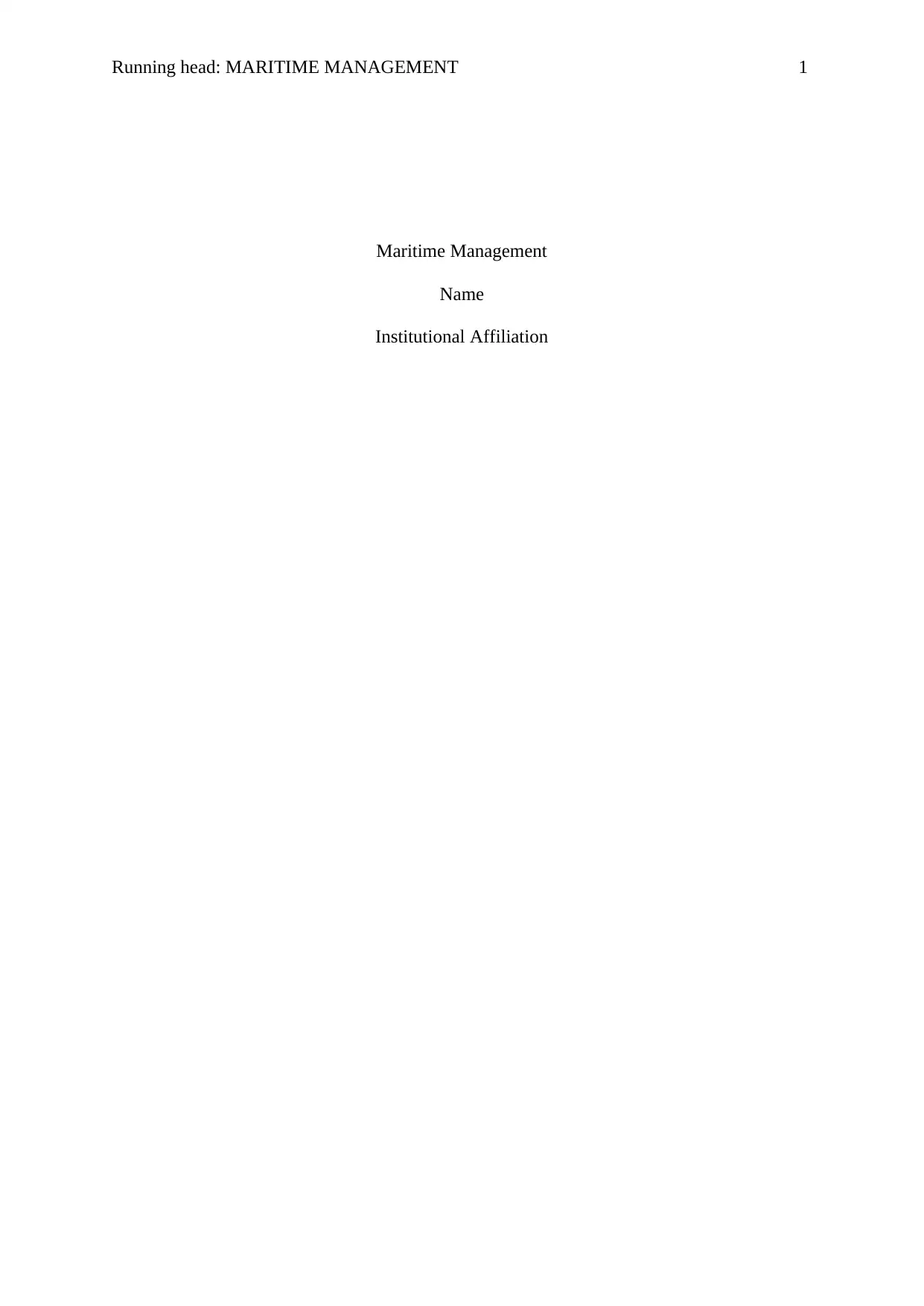
Running head: MARITIME MANAGEMENT 1
Maritime Management
Name
Institutional Affiliation
Maritime Management
Name
Institutional Affiliation
Secure Best Marks with AI Grader
Need help grading? Try our AI Grader for instant feedback on your assignments.
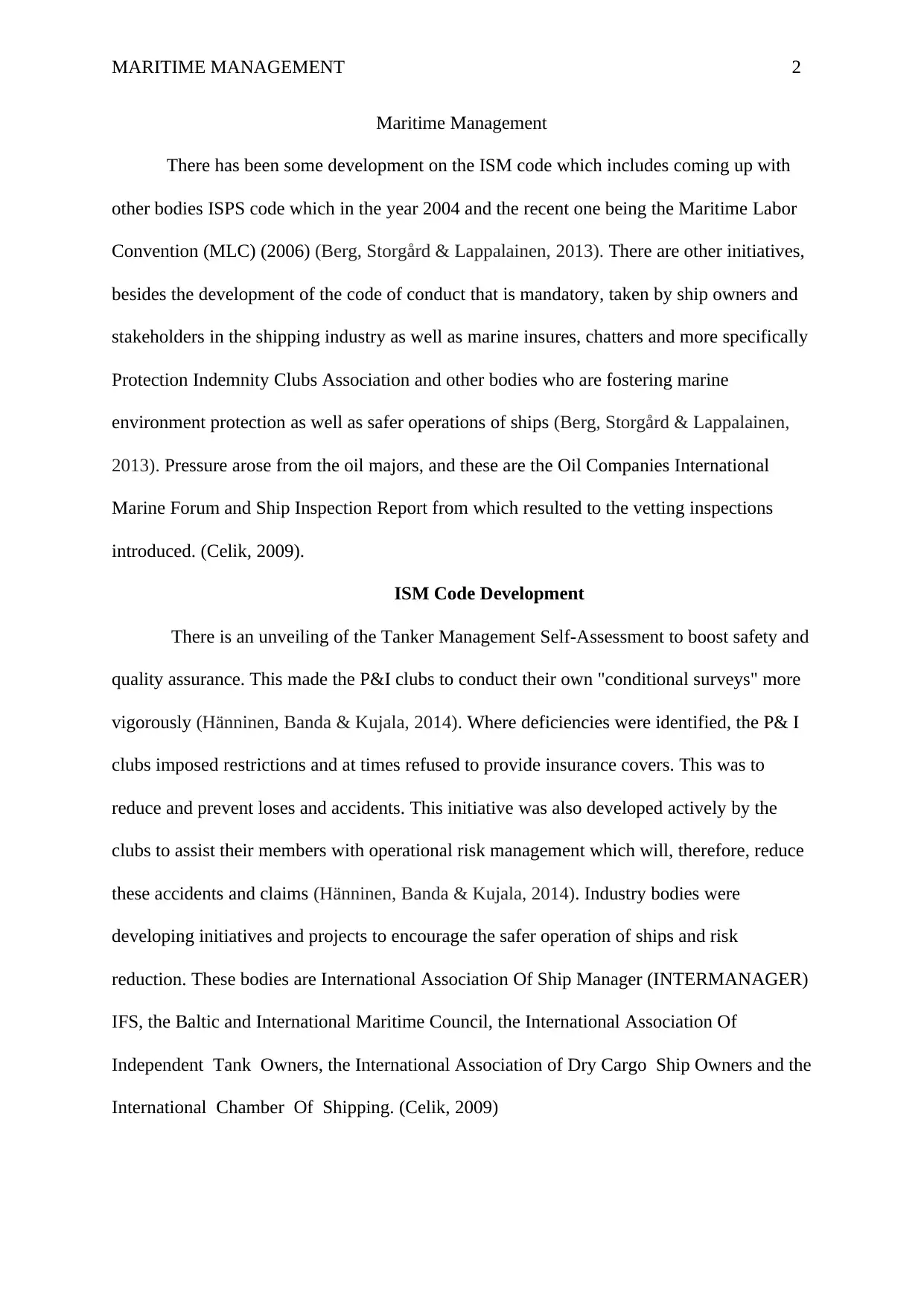
MARITIME MANAGEMENT 2
Maritime Management
There has been some development on the ISM code which includes coming up with
other bodies ISPS code which in the year 2004 and the recent one being the Maritime Labor
Convention (MLC) (2006) (Berg, Storgård & Lappalainen, 2013). There are other initiatives,
besides the development of the code of conduct that is mandatory, taken by ship owners and
stakeholders in the shipping industry as well as marine insures, chatters and more specifically
Protection Indemnity Clubs Association and other bodies who are fostering marine
environment protection as well as safer operations of ships (Berg, Storgård & Lappalainen,
2013). Pressure arose from the oil majors, and these are the Oil Companies International
Marine Forum and Ship Inspection Report from which resulted to the vetting inspections
introduced. (Celik, 2009).
ISM Code Development
There is an unveiling of the Tanker Management Self-Assessment to boost safety and
quality assurance. This made the P&I clubs to conduct their own "conditional surveys" more
vigorously (Hänninen, Banda & Kujala, 2014). Where deficiencies were identified, the P& I
clubs imposed restrictions and at times refused to provide insurance covers. This was to
reduce and prevent loses and accidents. This initiative was also developed actively by the
clubs to assist their members with operational risk management which will, therefore, reduce
these accidents and claims (Hänninen, Banda & Kujala, 2014). Industry bodies were
developing initiatives and projects to encourage the safer operation of ships and risk
reduction. These bodies are International Association Of Ship Manager (INTERMANAGER)
IFS, the Baltic and International Maritime Council, the International Association Of
Independent Tank Owners, the International Association of Dry Cargo Ship Owners and the
International Chamber Of Shipping. (Celik, 2009)
Maritime Management
There has been some development on the ISM code which includes coming up with
other bodies ISPS code which in the year 2004 and the recent one being the Maritime Labor
Convention (MLC) (2006) (Berg, Storgård & Lappalainen, 2013). There are other initiatives,
besides the development of the code of conduct that is mandatory, taken by ship owners and
stakeholders in the shipping industry as well as marine insures, chatters and more specifically
Protection Indemnity Clubs Association and other bodies who are fostering marine
environment protection as well as safer operations of ships (Berg, Storgård & Lappalainen,
2013). Pressure arose from the oil majors, and these are the Oil Companies International
Marine Forum and Ship Inspection Report from which resulted to the vetting inspections
introduced. (Celik, 2009).
ISM Code Development
There is an unveiling of the Tanker Management Self-Assessment to boost safety and
quality assurance. This made the P&I clubs to conduct their own "conditional surveys" more
vigorously (Hänninen, Banda & Kujala, 2014). Where deficiencies were identified, the P& I
clubs imposed restrictions and at times refused to provide insurance covers. This was to
reduce and prevent loses and accidents. This initiative was also developed actively by the
clubs to assist their members with operational risk management which will, therefore, reduce
these accidents and claims (Hänninen, Banda & Kujala, 2014). Industry bodies were
developing initiatives and projects to encourage the safer operation of ships and risk
reduction. These bodies are International Association Of Ship Manager (INTERMANAGER)
IFS, the Baltic and International Maritime Council, the International Association Of
Independent Tank Owners, the International Association of Dry Cargo Ship Owners and the
International Chamber Of Shipping. (Celik, 2009)
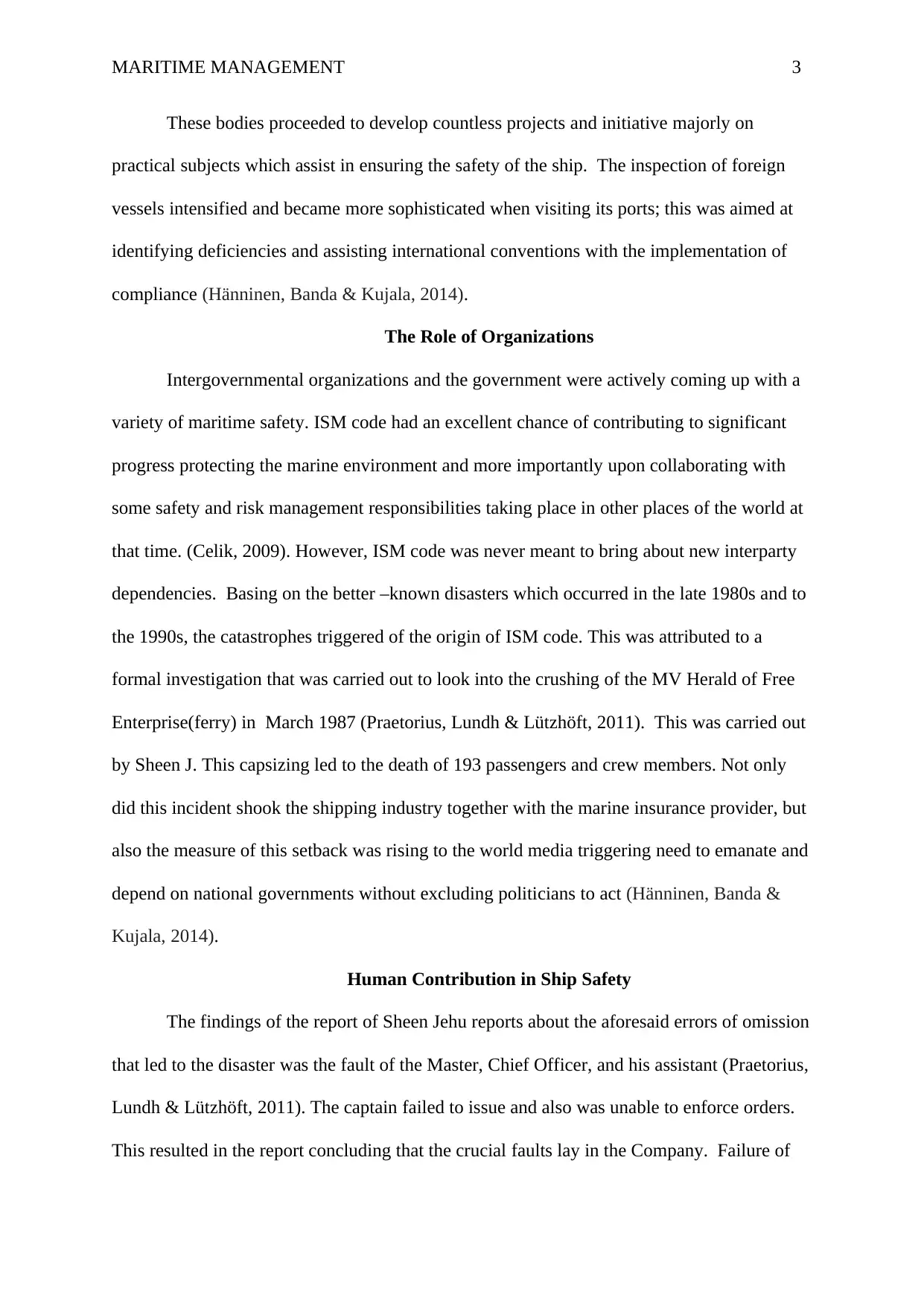
MARITIME MANAGEMENT 3
These bodies proceeded to develop countless projects and initiative majorly on
practical subjects which assist in ensuring the safety of the ship. The inspection of foreign
vessels intensified and became more sophisticated when visiting its ports; this was aimed at
identifying deficiencies and assisting international conventions with the implementation of
compliance (Hänninen, Banda & Kujala, 2014).
The Role of Organizations
Intergovernmental organizations and the government were actively coming up with a
variety of maritime safety. ISM code had an excellent chance of contributing to significant
progress protecting the marine environment and more importantly upon collaborating with
some safety and risk management responsibilities taking place in other places of the world at
that time. (Celik, 2009). However, ISM code was never meant to bring about new interparty
dependencies. Basing on the better –known disasters which occurred in the late 1980s and to
the 1990s, the catastrophes triggered of the origin of ISM code. This was attributed to a
formal investigation that was carried out to look into the crushing of the MV Herald of Free
Enterprise(ferry) in March 1987 (Praetorius, Lundh & Lützhöft, 2011). This was carried out
by Sheen J. This capsizing led to the death of 193 passengers and crew members. Not only
did this incident shook the shipping industry together with the marine insurance provider, but
also the measure of this setback was rising to the world media triggering need to emanate and
depend on national governments without excluding politicians to act (Hänninen, Banda &
Kujala, 2014).
Human Contribution in Ship Safety
The findings of the report of Sheen Jehu reports about the aforesaid errors of omission
that led to the disaster was the fault of the Master, Chief Officer, and his assistant (Praetorius,
Lundh & Lützhöft, 2011). The captain failed to issue and also was unable to enforce orders.
This resulted in the report concluding that the crucial faults lay in the Company. Failure of
These bodies proceeded to develop countless projects and initiative majorly on
practical subjects which assist in ensuring the safety of the ship. The inspection of foreign
vessels intensified and became more sophisticated when visiting its ports; this was aimed at
identifying deficiencies and assisting international conventions with the implementation of
compliance (Hänninen, Banda & Kujala, 2014).
The Role of Organizations
Intergovernmental organizations and the government were actively coming up with a
variety of maritime safety. ISM code had an excellent chance of contributing to significant
progress protecting the marine environment and more importantly upon collaborating with
some safety and risk management responsibilities taking place in other places of the world at
that time. (Celik, 2009). However, ISM code was never meant to bring about new interparty
dependencies. Basing on the better –known disasters which occurred in the late 1980s and to
the 1990s, the catastrophes triggered of the origin of ISM code. This was attributed to a
formal investigation that was carried out to look into the crushing of the MV Herald of Free
Enterprise(ferry) in March 1987 (Praetorius, Lundh & Lützhöft, 2011). This was carried out
by Sheen J. This capsizing led to the death of 193 passengers and crew members. Not only
did this incident shook the shipping industry together with the marine insurance provider, but
also the measure of this setback was rising to the world media triggering need to emanate and
depend on national governments without excluding politicians to act (Hänninen, Banda &
Kujala, 2014).
Human Contribution in Ship Safety
The findings of the report of Sheen Jehu reports about the aforesaid errors of omission
that led to the disaster was the fault of the Master, Chief Officer, and his assistant (Praetorius,
Lundh & Lützhöft, 2011). The captain failed to issue and also was unable to enforce orders.
This resulted in the report concluding that the crucial faults lay in the Company. Failure of
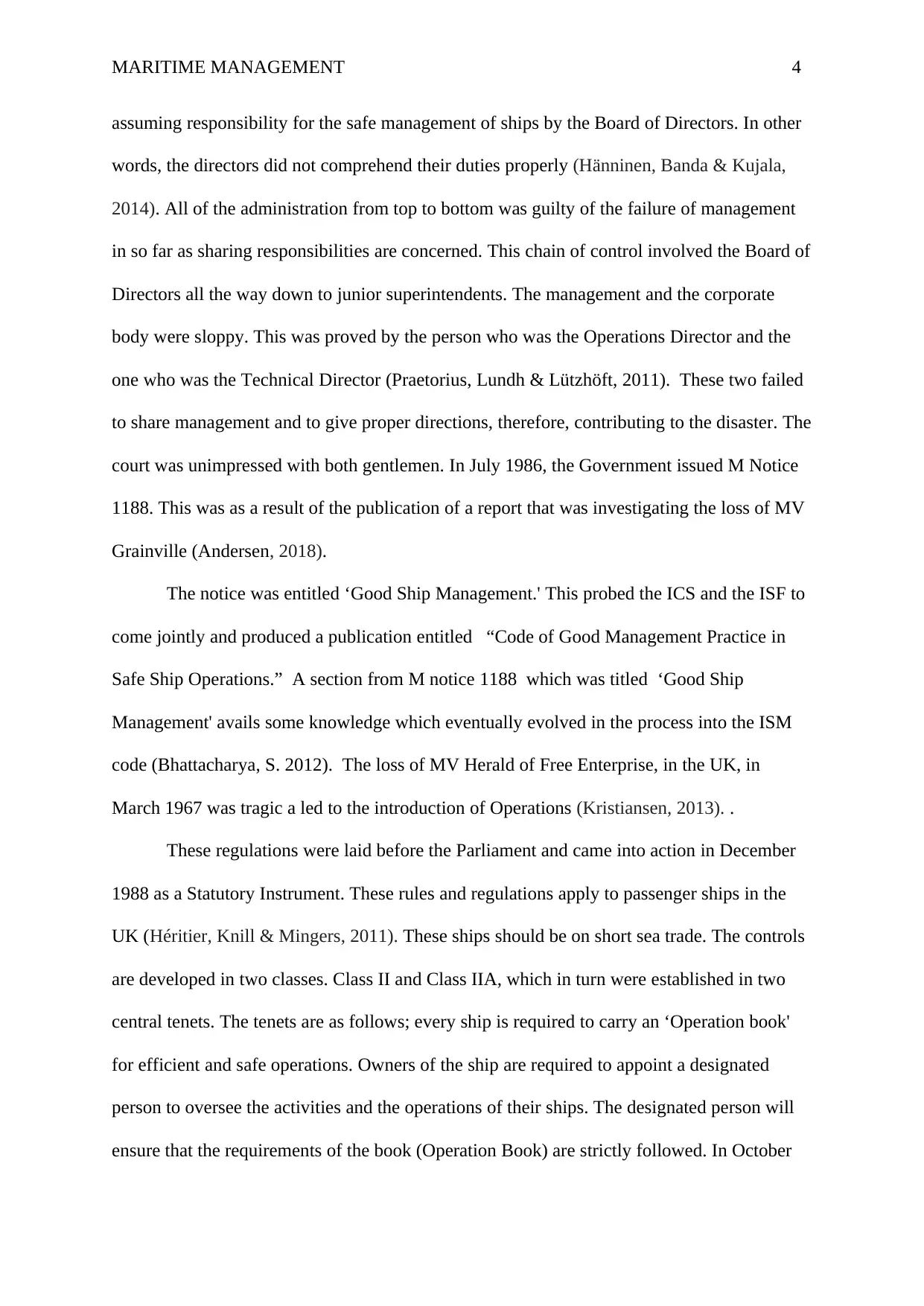
MARITIME MANAGEMENT 4
assuming responsibility for the safe management of ships by the Board of Directors. In other
words, the directors did not comprehend their duties properly (Hänninen, Banda & Kujala,
2014). All of the administration from top to bottom was guilty of the failure of management
in so far as sharing responsibilities are concerned. This chain of control involved the Board of
Directors all the way down to junior superintendents. The management and the corporate
body were sloppy. This was proved by the person who was the Operations Director and the
one who was the Technical Director (Praetorius, Lundh & Lützhöft, 2011). These two failed
to share management and to give proper directions, therefore, contributing to the disaster. The
court was unimpressed with both gentlemen. In July 1986, the Government issued M Notice
1188. This was as a result of the publication of a report that was investigating the loss of MV
Grainville (Andersen, 2018).
The notice was entitled ‘Good Ship Management.' This probed the ICS and the ISF to
come jointly and produced a publication entitled “Code of Good Management Practice in
Safe Ship Operations.” A section from M notice 1188 which was titled ‘Good Ship
Management' avails some knowledge which eventually evolved in the process into the ISM
code (Bhattacharya, S. 2012). The loss of MV Herald of Free Enterprise, in the UK, in
March 1967 was tragic a led to the introduction of Operations (Kristiansen, 2013). .
These regulations were laid before the Parliament and came into action in December
1988 as a Statutory Instrument. These rules and regulations apply to passenger ships in the
UK (Héritier, Knill & Mingers, 2011). These ships should be on short sea trade. The controls
are developed in two classes. Class II and Class IIA, which in turn were established in two
central tenets. The tenets are as follows; every ship is required to carry an ‘Operation book'
for efficient and safe operations. Owners of the ship are required to appoint a designated
person to oversee the activities and the operations of their ships. The designated person will
ensure that the requirements of the book (Operation Book) are strictly followed. In October
assuming responsibility for the safe management of ships by the Board of Directors. In other
words, the directors did not comprehend their duties properly (Hänninen, Banda & Kujala,
2014). All of the administration from top to bottom was guilty of the failure of management
in so far as sharing responsibilities are concerned. This chain of control involved the Board of
Directors all the way down to junior superintendents. The management and the corporate
body were sloppy. This was proved by the person who was the Operations Director and the
one who was the Technical Director (Praetorius, Lundh & Lützhöft, 2011). These two failed
to share management and to give proper directions, therefore, contributing to the disaster. The
court was unimpressed with both gentlemen. In July 1986, the Government issued M Notice
1188. This was as a result of the publication of a report that was investigating the loss of MV
Grainville (Andersen, 2018).
The notice was entitled ‘Good Ship Management.' This probed the ICS and the ISF to
come jointly and produced a publication entitled “Code of Good Management Practice in
Safe Ship Operations.” A section from M notice 1188 which was titled ‘Good Ship
Management' avails some knowledge which eventually evolved in the process into the ISM
code (Bhattacharya, S. 2012). The loss of MV Herald of Free Enterprise, in the UK, in
March 1967 was tragic a led to the introduction of Operations (Kristiansen, 2013). .
These regulations were laid before the Parliament and came into action in December
1988 as a Statutory Instrument. These rules and regulations apply to passenger ships in the
UK (Héritier, Knill & Mingers, 2011). These ships should be on short sea trade. The controls
are developed in two classes. Class II and Class IIA, which in turn were established in two
central tenets. The tenets are as follows; every ship is required to carry an ‘Operation book'
for efficient and safe operations. Owners of the ship are required to appoint a designated
person to oversee the activities and the operations of their ships. The designated person will
ensure that the requirements of the book (Operation Book) are strictly followed. In October
Secure Best Marks with AI Grader
Need help grading? Try our AI Grader for instant feedback on your assignments.
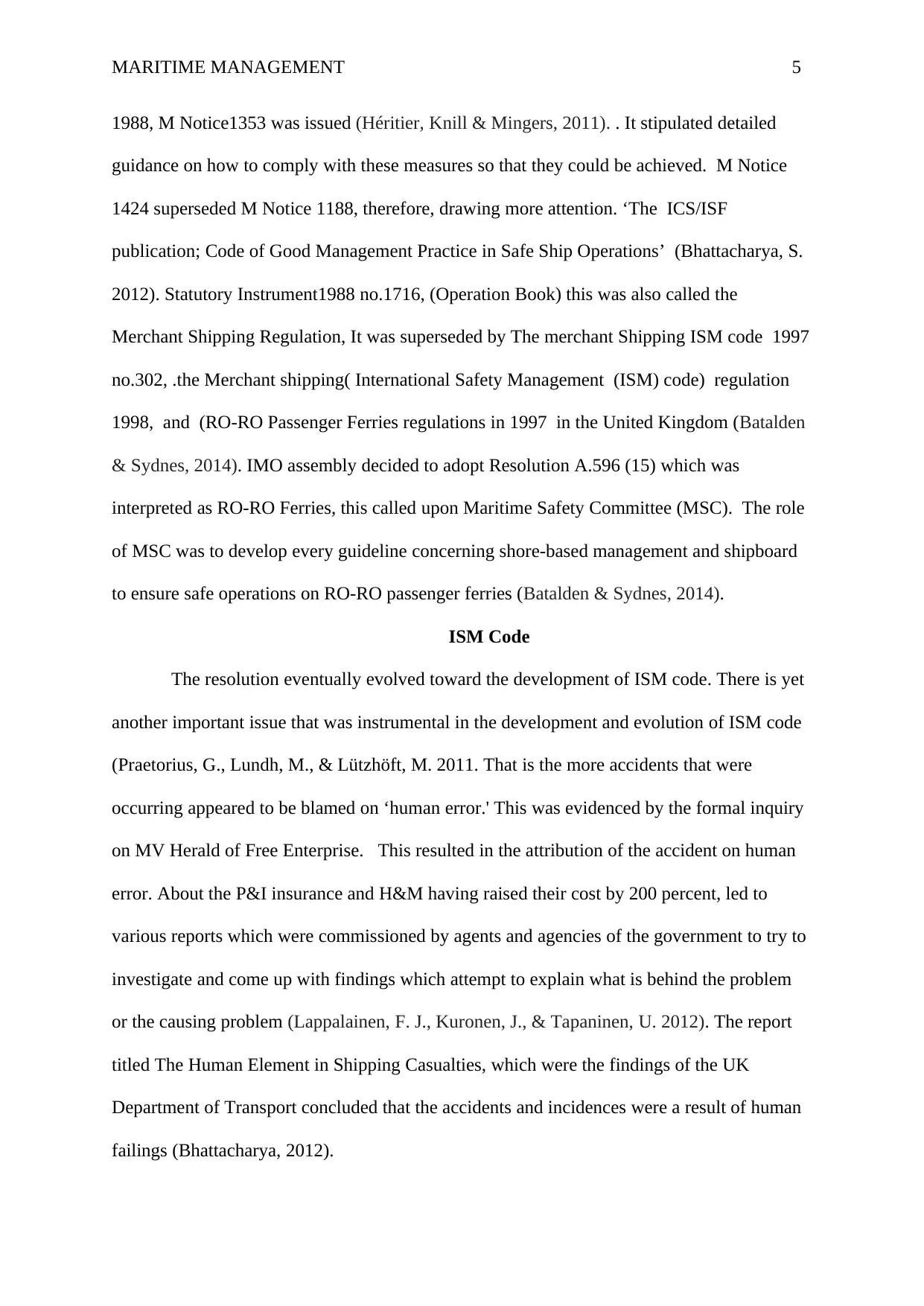
MARITIME MANAGEMENT 5
1988, M Notice1353 was issued (Héritier, Knill & Mingers, 2011). . It stipulated detailed
guidance on how to comply with these measures so that they could be achieved. M Notice
1424 superseded M Notice 1188, therefore, drawing more attention. ‘The ICS/ISF
publication; Code of Good Management Practice in Safe Ship Operations’ (Bhattacharya, S.
2012). Statutory Instrument1988 no.1716, (Operation Book) this was also called the
Merchant Shipping Regulation, It was superseded by The merchant Shipping ISM code 1997
no.302, .the Merchant shipping( International Safety Management (ISM) code) regulation
1998, and (RO-RO Passenger Ferries regulations in 1997 in the United Kingdom (Batalden
& Sydnes, 2014). IMO assembly decided to adopt Resolution A.596 (15) which was
interpreted as RO-RO Ferries, this called upon Maritime Safety Committee (MSC). The role
of MSC was to develop every guideline concerning shore-based management and shipboard
to ensure safe operations on RO-RO passenger ferries (Batalden & Sydnes, 2014).
ISM Code
The resolution eventually evolved toward the development of ISM code. There is yet
another important issue that was instrumental in the development and evolution of ISM code
(Praetorius, G., Lundh, M., & Lützhöft, M. 2011. That is the more accidents that were
occurring appeared to be blamed on ‘human error.' This was evidenced by the formal inquiry
on MV Herald of Free Enterprise. This resulted in the attribution of the accident on human
error. About the P&I insurance and H&M having raised their cost by 200 percent, led to
various reports which were commissioned by agents and agencies of the government to try to
investigate and come up with findings which attempt to explain what is behind the problem
or the causing problem (Lappalainen, F. J., Kuronen, J., & Tapaninen, U. 2012). The report
titled The Human Element in Shipping Casualties, which were the findings of the UK
Department of Transport concluded that the accidents and incidences were a result of human
failings (Bhattacharya, 2012).
1988, M Notice1353 was issued (Héritier, Knill & Mingers, 2011). . It stipulated detailed
guidance on how to comply with these measures so that they could be achieved. M Notice
1424 superseded M Notice 1188, therefore, drawing more attention. ‘The ICS/ISF
publication; Code of Good Management Practice in Safe Ship Operations’ (Bhattacharya, S.
2012). Statutory Instrument1988 no.1716, (Operation Book) this was also called the
Merchant Shipping Regulation, It was superseded by The merchant Shipping ISM code 1997
no.302, .the Merchant shipping( International Safety Management (ISM) code) regulation
1998, and (RO-RO Passenger Ferries regulations in 1997 in the United Kingdom (Batalden
& Sydnes, 2014). IMO assembly decided to adopt Resolution A.596 (15) which was
interpreted as RO-RO Ferries, this called upon Maritime Safety Committee (MSC). The role
of MSC was to develop every guideline concerning shore-based management and shipboard
to ensure safe operations on RO-RO passenger ferries (Batalden & Sydnes, 2014).
ISM Code
The resolution eventually evolved toward the development of ISM code. There is yet
another important issue that was instrumental in the development and evolution of ISM code
(Praetorius, G., Lundh, M., & Lützhöft, M. 2011. That is the more accidents that were
occurring appeared to be blamed on ‘human error.' This was evidenced by the formal inquiry
on MV Herald of Free Enterprise. This resulted in the attribution of the accident on human
error. About the P&I insurance and H&M having raised their cost by 200 percent, led to
various reports which were commissioned by agents and agencies of the government to try to
investigate and come up with findings which attempt to explain what is behind the problem
or the causing problem (Lappalainen, F. J., Kuronen, J., & Tapaninen, U. 2012). The report
titled The Human Element in Shipping Casualties, which were the findings of the UK
Department of Transport concluded that the accidents and incidences were a result of human
failings (Bhattacharya, 2012).
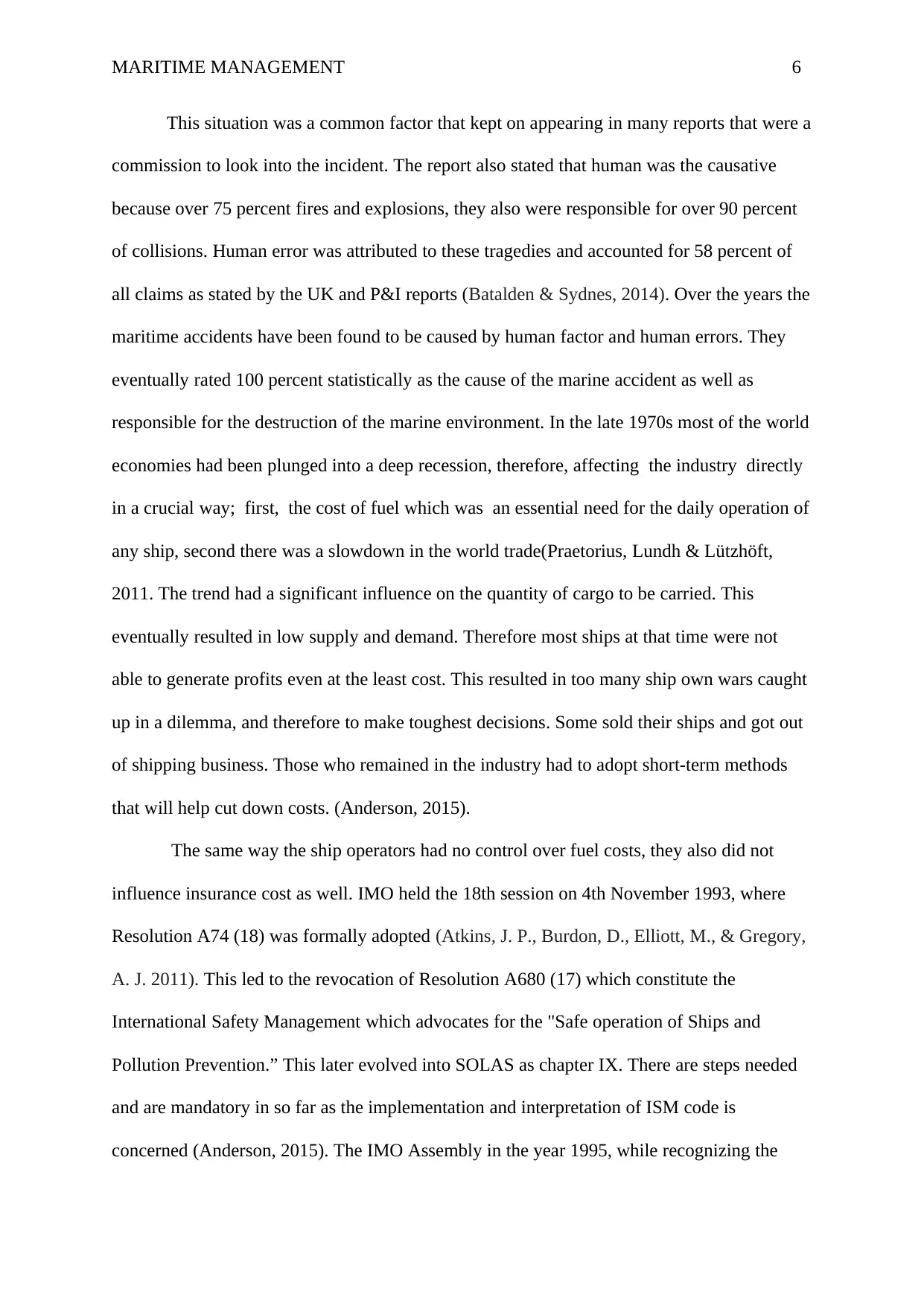
MARITIME MANAGEMENT 6
This situation was a common factor that kept on appearing in many reports that were a
commission to look into the incident. The report also stated that human was the causative
because over 75 percent fires and explosions, they also were responsible for over 90 percent
of collisions. Human error was attributed to these tragedies and accounted for 58 percent of
all claims as stated by the UK and P&I reports (Batalden & Sydnes, 2014). Over the years the
maritime accidents have been found to be caused by human factor and human errors. They
eventually rated 100 percent statistically as the cause of the marine accident as well as
responsible for the destruction of the marine environment. In the late 1970s most of the world
economies had been plunged into a deep recession, therefore, affecting the industry directly
in a crucial way; first, the cost of fuel which was an essential need for the daily operation of
any ship, second there was a slowdown in the world trade(Praetorius, Lundh & Lützhöft,
2011. The trend had a significant influence on the quantity of cargo to be carried. This
eventually resulted in low supply and demand. Therefore most ships at that time were not
able to generate profits even at the least cost. This resulted in too many ship own wars caught
up in a dilemma, and therefore to make toughest decisions. Some sold their ships and got out
of shipping business. Those who remained in the industry had to adopt short-term methods
that will help cut down costs. (Anderson, 2015).
The same way the ship operators had no control over fuel costs, they also did not
influence insurance cost as well. IMO held the 18th session on 4th November 1993, where
Resolution A74 (18) was formally adopted (Atkins, J. P., Burdon, D., Elliott, M., & Gregory,
A. J. 2011). This led to the revocation of Resolution A680 (17) which constitute the
International Safety Management which advocates for the "Safe operation of Ships and
Pollution Prevention.” This later evolved into SOLAS as chapter IX. There are steps needed
and are mandatory in so far as the implementation and interpretation of ISM code is
concerned (Anderson, 2015). The IMO Assembly in the year 1995, while recognizing the
This situation was a common factor that kept on appearing in many reports that were a
commission to look into the incident. The report also stated that human was the causative
because over 75 percent fires and explosions, they also were responsible for over 90 percent
of collisions. Human error was attributed to these tragedies and accounted for 58 percent of
all claims as stated by the UK and P&I reports (Batalden & Sydnes, 2014). Over the years the
maritime accidents have been found to be caused by human factor and human errors. They
eventually rated 100 percent statistically as the cause of the marine accident as well as
responsible for the destruction of the marine environment. In the late 1970s most of the world
economies had been plunged into a deep recession, therefore, affecting the industry directly
in a crucial way; first, the cost of fuel which was an essential need for the daily operation of
any ship, second there was a slowdown in the world trade(Praetorius, Lundh & Lützhöft,
2011. The trend had a significant influence on the quantity of cargo to be carried. This
eventually resulted in low supply and demand. Therefore most ships at that time were not
able to generate profits even at the least cost. This resulted in too many ship own wars caught
up in a dilemma, and therefore to make toughest decisions. Some sold their ships and got out
of shipping business. Those who remained in the industry had to adopt short-term methods
that will help cut down costs. (Anderson, 2015).
The same way the ship operators had no control over fuel costs, they also did not
influence insurance cost as well. IMO held the 18th session on 4th November 1993, where
Resolution A74 (18) was formally adopted (Atkins, J. P., Burdon, D., Elliott, M., & Gregory,
A. J. 2011). This led to the revocation of Resolution A680 (17) which constitute the
International Safety Management which advocates for the "Safe operation of Ships and
Pollution Prevention.” This later evolved into SOLAS as chapter IX. There are steps needed
and are mandatory in so far as the implementation and interpretation of ISM code is
concerned (Anderson, 2015). The IMO Assembly in the year 1995, while recognizing the
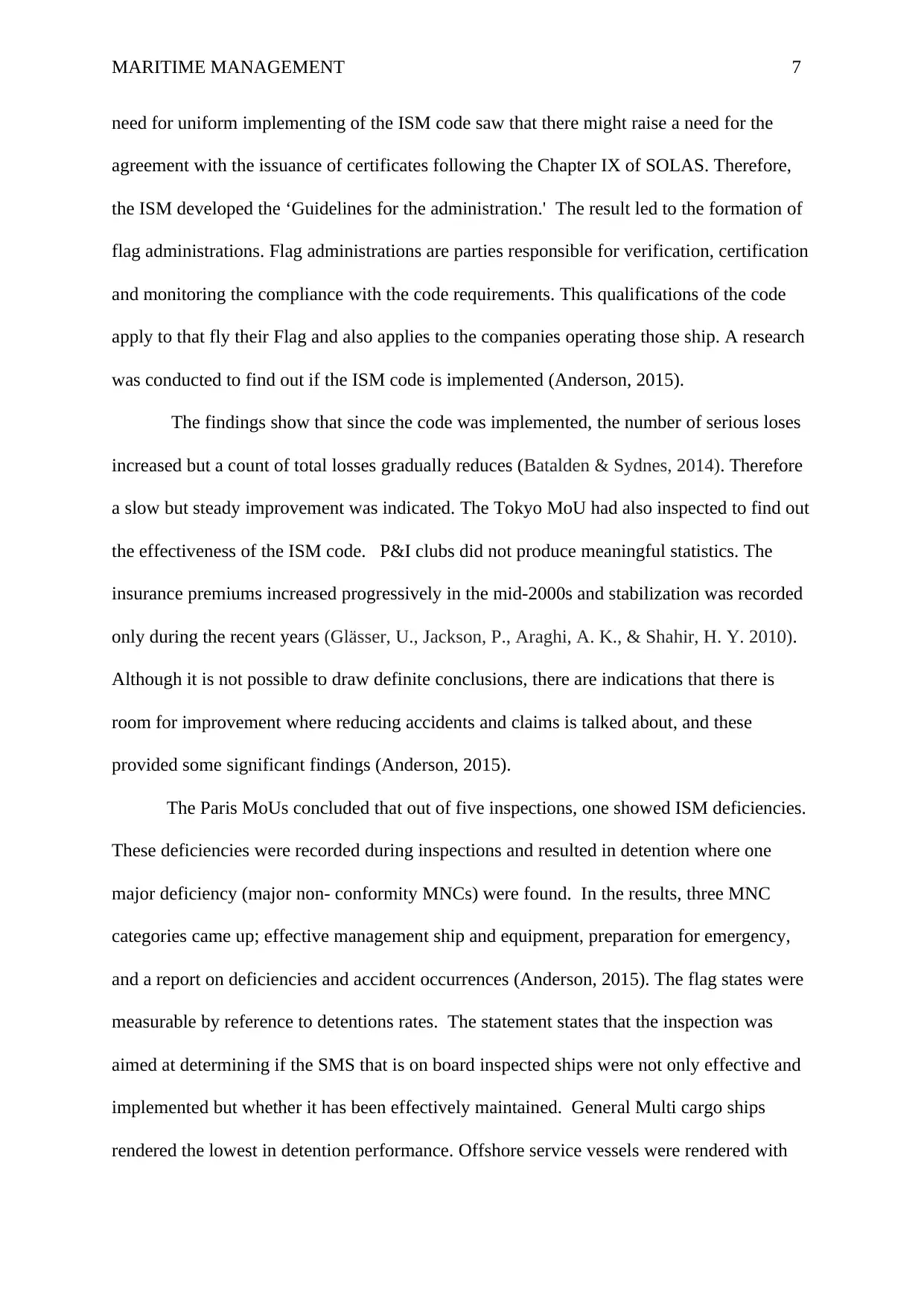
MARITIME MANAGEMENT 7
need for uniform implementing of the ISM code saw that there might raise a need for the
agreement with the issuance of certificates following the Chapter IX of SOLAS. Therefore,
the ISM developed the ‘Guidelines for the administration.' The result led to the formation of
flag administrations. Flag administrations are parties responsible for verification, certification
and monitoring the compliance with the code requirements. This qualifications of the code
apply to that fly their Flag and also applies to the companies operating those ship. A research
was conducted to find out if the ISM code is implemented (Anderson, 2015).
The findings show that since the code was implemented, the number of serious loses
increased but a count of total losses gradually reduces (Batalden & Sydnes, 2014). Therefore
a slow but steady improvement was indicated. The Tokyo MoU had also inspected to find out
the effectiveness of the ISM code. P&I clubs did not produce meaningful statistics. The
insurance premiums increased progressively in the mid-2000s and stabilization was recorded
only during the recent years (Glässer, U., Jackson, P., Araghi, A. K., & Shahir, H. Y. 2010).
Although it is not possible to draw definite conclusions, there are indications that there is
room for improvement where reducing accidents and claims is talked about, and these
provided some significant findings (Anderson, 2015).
The Paris MoUs concluded that out of five inspections, one showed ISM deficiencies.
These deficiencies were recorded during inspections and resulted in detention where one
major deficiency (major non- conformity MNCs) were found. In the results, three MNC
categories came up; effective management ship and equipment, preparation for emergency,
and a report on deficiencies and accident occurrences (Anderson, 2015). The flag states were
measurable by reference to detentions rates. The statement states that the inspection was
aimed at determining if the SMS that is on board inspected ships were not only effective and
implemented but whether it has been effectively maintained. General Multi cargo ships
rendered the lowest in detention performance. Offshore service vessels were rendered with
need for uniform implementing of the ISM code saw that there might raise a need for the
agreement with the issuance of certificates following the Chapter IX of SOLAS. Therefore,
the ISM developed the ‘Guidelines for the administration.' The result led to the formation of
flag administrations. Flag administrations are parties responsible for verification, certification
and monitoring the compliance with the code requirements. This qualifications of the code
apply to that fly their Flag and also applies to the companies operating those ship. A research
was conducted to find out if the ISM code is implemented (Anderson, 2015).
The findings show that since the code was implemented, the number of serious loses
increased but a count of total losses gradually reduces (Batalden & Sydnes, 2014). Therefore
a slow but steady improvement was indicated. The Tokyo MoU had also inspected to find out
the effectiveness of the ISM code. P&I clubs did not produce meaningful statistics. The
insurance premiums increased progressively in the mid-2000s and stabilization was recorded
only during the recent years (Glässer, U., Jackson, P., Araghi, A. K., & Shahir, H. Y. 2010).
Although it is not possible to draw definite conclusions, there are indications that there is
room for improvement where reducing accidents and claims is talked about, and these
provided some significant findings (Anderson, 2015).
The Paris MoUs concluded that out of five inspections, one showed ISM deficiencies.
These deficiencies were recorded during inspections and resulted in detention where one
major deficiency (major non- conformity MNCs) were found. In the results, three MNC
categories came up; effective management ship and equipment, preparation for emergency,
and a report on deficiencies and accident occurrences (Anderson, 2015). The flag states were
measurable by reference to detentions rates. The statement states that the inspection was
aimed at determining if the SMS that is on board inspected ships were not only effective and
implemented but whether it has been effectively maintained. General Multi cargo ships
rendered the lowest in detention performance. Offshore service vessels were rendered with
Paraphrase This Document
Need a fresh take? Get an instant paraphrase of this document with our AI Paraphraser
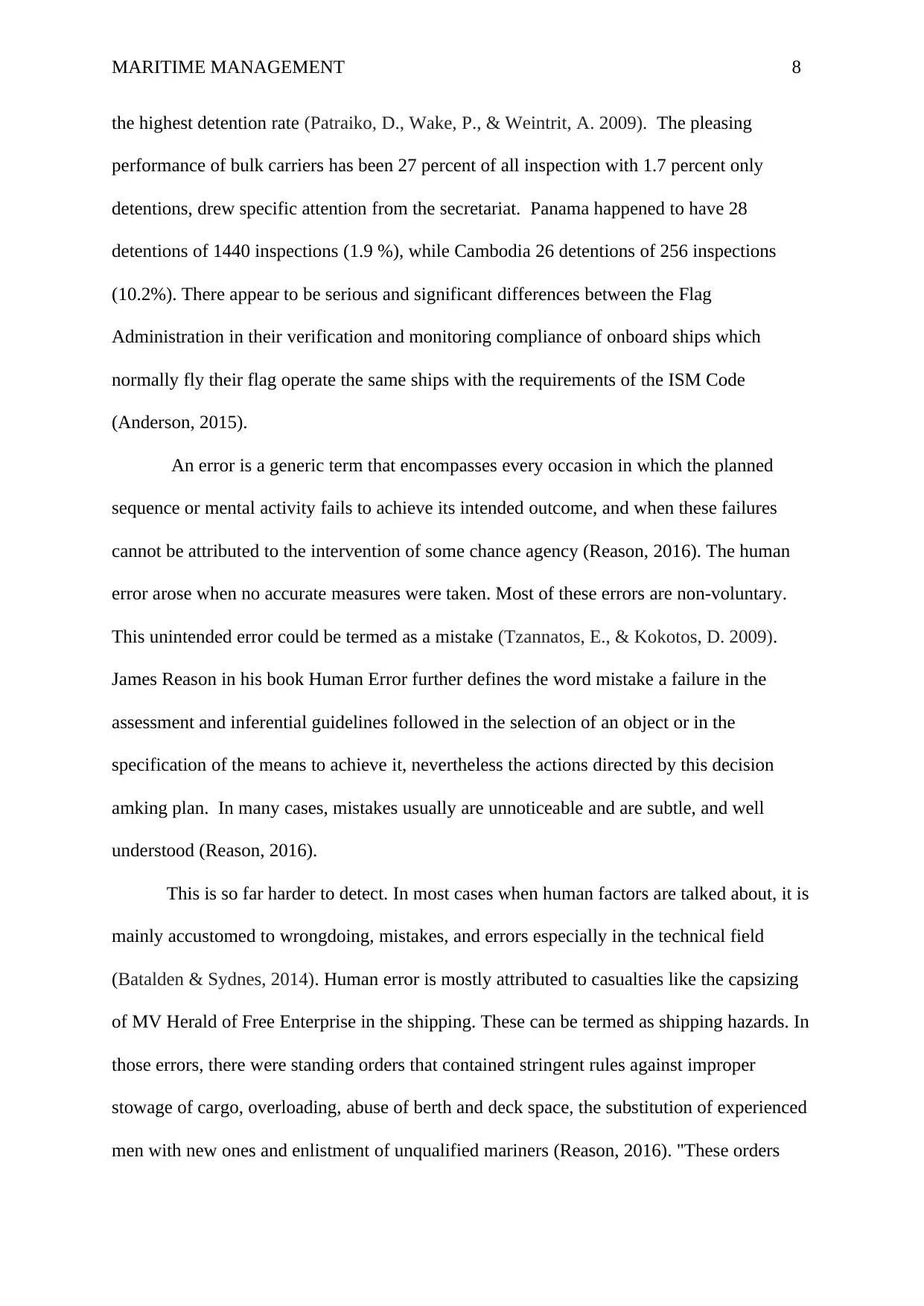
MARITIME MANAGEMENT 8
the highest detention rate (Patraiko, D., Wake, P., & Weintrit, A. 2009). The pleasing
performance of bulk carriers has been 27 percent of all inspection with 1.7 percent only
detentions, drew specific attention from the secretariat. Panama happened to have 28
detentions of 1440 inspections (1.9 %), while Cambodia 26 detentions of 256 inspections
(10.2%). There appear to be serious and significant differences between the Flag
Administration in their verification and monitoring compliance of onboard ships which
normally fly their flag operate the same ships with the requirements of the ISM Code
(Anderson, 2015).
An error is a generic term that encompasses every occasion in which the planned
sequence or mental activity fails to achieve its intended outcome, and when these failures
cannot be attributed to the intervention of some chance agency (Reason, 2016). The human
error arose when no accurate measures were taken. Most of these errors are non-voluntary.
This unintended error could be termed as a mistake (Tzannatos, E., & Kokotos, D. 2009).
James Reason in his book Human Error further defines the word mistake a failure in the
assessment and inferential guidelines followed in the selection of an object or in the
specification of the means to achieve it, nevertheless the actions directed by this decision
amking plan. In many cases, mistakes usually are unnoticeable and are subtle, and well
understood (Reason, 2016).
This is so far harder to detect. In most cases when human factors are talked about, it is
mainly accustomed to wrongdoing, mistakes, and errors especially in the technical field
(Batalden & Sydnes, 2014). Human error is mostly attributed to casualties like the capsizing
of MV Herald of Free Enterprise in the shipping. These can be termed as shipping hazards. In
those errors, there were standing orders that contained stringent rules against improper
stowage of cargo, overloading, abuse of berth and deck space, the substitution of experienced
men with new ones and enlistment of unqualified mariners (Reason, 2016). "These orders
the highest detention rate (Patraiko, D., Wake, P., & Weintrit, A. 2009). The pleasing
performance of bulk carriers has been 27 percent of all inspection with 1.7 percent only
detentions, drew specific attention from the secretariat. Panama happened to have 28
detentions of 1440 inspections (1.9 %), while Cambodia 26 detentions of 256 inspections
(10.2%). There appear to be serious and significant differences between the Flag
Administration in their verification and monitoring compliance of onboard ships which
normally fly their flag operate the same ships with the requirements of the ISM Code
(Anderson, 2015).
An error is a generic term that encompasses every occasion in which the planned
sequence or mental activity fails to achieve its intended outcome, and when these failures
cannot be attributed to the intervention of some chance agency (Reason, 2016). The human
error arose when no accurate measures were taken. Most of these errors are non-voluntary.
This unintended error could be termed as a mistake (Tzannatos, E., & Kokotos, D. 2009).
James Reason in his book Human Error further defines the word mistake a failure in the
assessment and inferential guidelines followed in the selection of an object or in the
specification of the means to achieve it, nevertheless the actions directed by this decision
amking plan. In many cases, mistakes usually are unnoticeable and are subtle, and well
understood (Reason, 2016).
This is so far harder to detect. In most cases when human factors are talked about, it is
mainly accustomed to wrongdoing, mistakes, and errors especially in the technical field
(Batalden & Sydnes, 2014). Human error is mostly attributed to casualties like the capsizing
of MV Herald of Free Enterprise in the shipping. These can be termed as shipping hazards. In
those errors, there were standing orders that contained stringent rules against improper
stowage of cargo, overloading, abuse of berth and deck space, the substitution of experienced
men with new ones and enlistment of unqualified mariners (Reason, 2016). "These orders
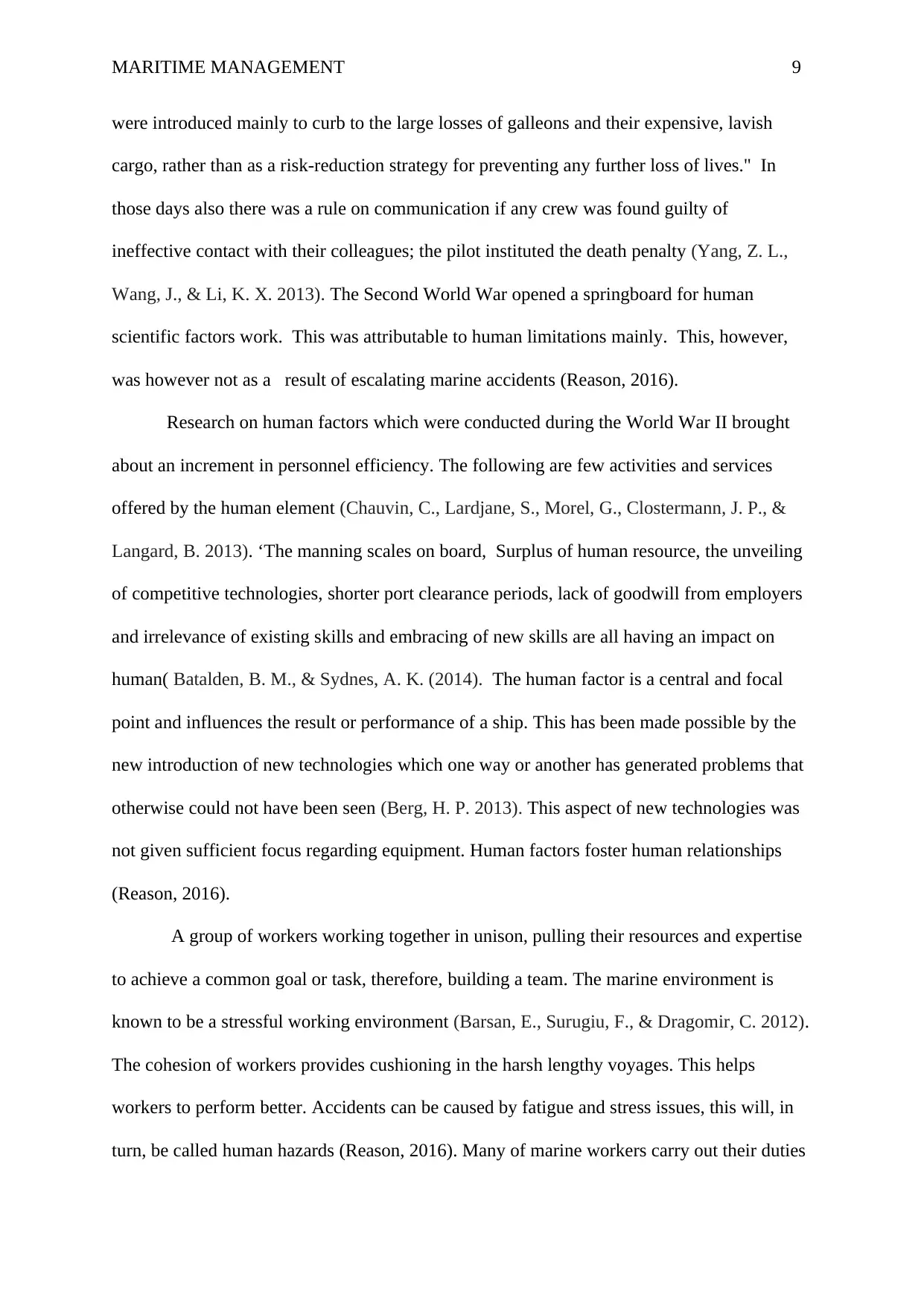
MARITIME MANAGEMENT 9
were introduced mainly to curb to the large losses of galleons and their expensive, lavish
cargo, rather than as a risk-reduction strategy for preventing any further loss of lives." In
those days also there was a rule on communication if any crew was found guilty of
ineffective contact with their colleagues; the pilot instituted the death penalty (Yang, Z. L.,
Wang, J., & Li, K. X. 2013). The Second World War opened a springboard for human
scientific factors work. This was attributable to human limitations mainly. This, however,
was however not as a result of escalating marine accidents (Reason, 2016).
Research on human factors which were conducted during the World War II brought
about an increment in personnel efficiency. The following are few activities and services
offered by the human element (Chauvin, C., Lardjane, S., Morel, G., Clostermann, J. P., &
Langard, B. 2013). ‘The manning scales on board, Surplus of human resource, the unveiling
of competitive technologies, shorter port clearance periods, lack of goodwill from employers
and irrelevance of existing skills and embracing of new skills are all having an impact on
human( Batalden, B. M., & Sydnes, A. K. (2014). The human factor is a central and focal
point and influences the result or performance of a ship. This has been made possible by the
new introduction of new technologies which one way or another has generated problems that
otherwise could not have been seen (Berg, H. P. 2013). This aspect of new technologies was
not given sufficient focus regarding equipment. Human factors foster human relationships
(Reason, 2016).
A group of workers working together in unison, pulling their resources and expertise
to achieve a common goal or task, therefore, building a team. The marine environment is
known to be a stressful working environment (Barsan, E., Surugiu, F., & Dragomir, C. 2012).
The cohesion of workers provides cushioning in the harsh lengthy voyages. This helps
workers to perform better. Accidents can be caused by fatigue and stress issues, this will, in
turn, be called human hazards (Reason, 2016). Many of marine workers carry out their duties
were introduced mainly to curb to the large losses of galleons and their expensive, lavish
cargo, rather than as a risk-reduction strategy for preventing any further loss of lives." In
those days also there was a rule on communication if any crew was found guilty of
ineffective contact with their colleagues; the pilot instituted the death penalty (Yang, Z. L.,
Wang, J., & Li, K. X. 2013). The Second World War opened a springboard for human
scientific factors work. This was attributable to human limitations mainly. This, however,
was however not as a result of escalating marine accidents (Reason, 2016).
Research on human factors which were conducted during the World War II brought
about an increment in personnel efficiency. The following are few activities and services
offered by the human element (Chauvin, C., Lardjane, S., Morel, G., Clostermann, J. P., &
Langard, B. 2013). ‘The manning scales on board, Surplus of human resource, the unveiling
of competitive technologies, shorter port clearance periods, lack of goodwill from employers
and irrelevance of existing skills and embracing of new skills are all having an impact on
human( Batalden, B. M., & Sydnes, A. K. (2014). The human factor is a central and focal
point and influences the result or performance of a ship. This has been made possible by the
new introduction of new technologies which one way or another has generated problems that
otherwise could not have been seen (Berg, H. P. 2013). This aspect of new technologies was
not given sufficient focus regarding equipment. Human factors foster human relationships
(Reason, 2016).
A group of workers working together in unison, pulling their resources and expertise
to achieve a common goal or task, therefore, building a team. The marine environment is
known to be a stressful working environment (Barsan, E., Surugiu, F., & Dragomir, C. 2012).
The cohesion of workers provides cushioning in the harsh lengthy voyages. This helps
workers to perform better. Accidents can be caused by fatigue and stress issues, this will, in
turn, be called human hazards (Reason, 2016). Many of marine workers carry out their duties
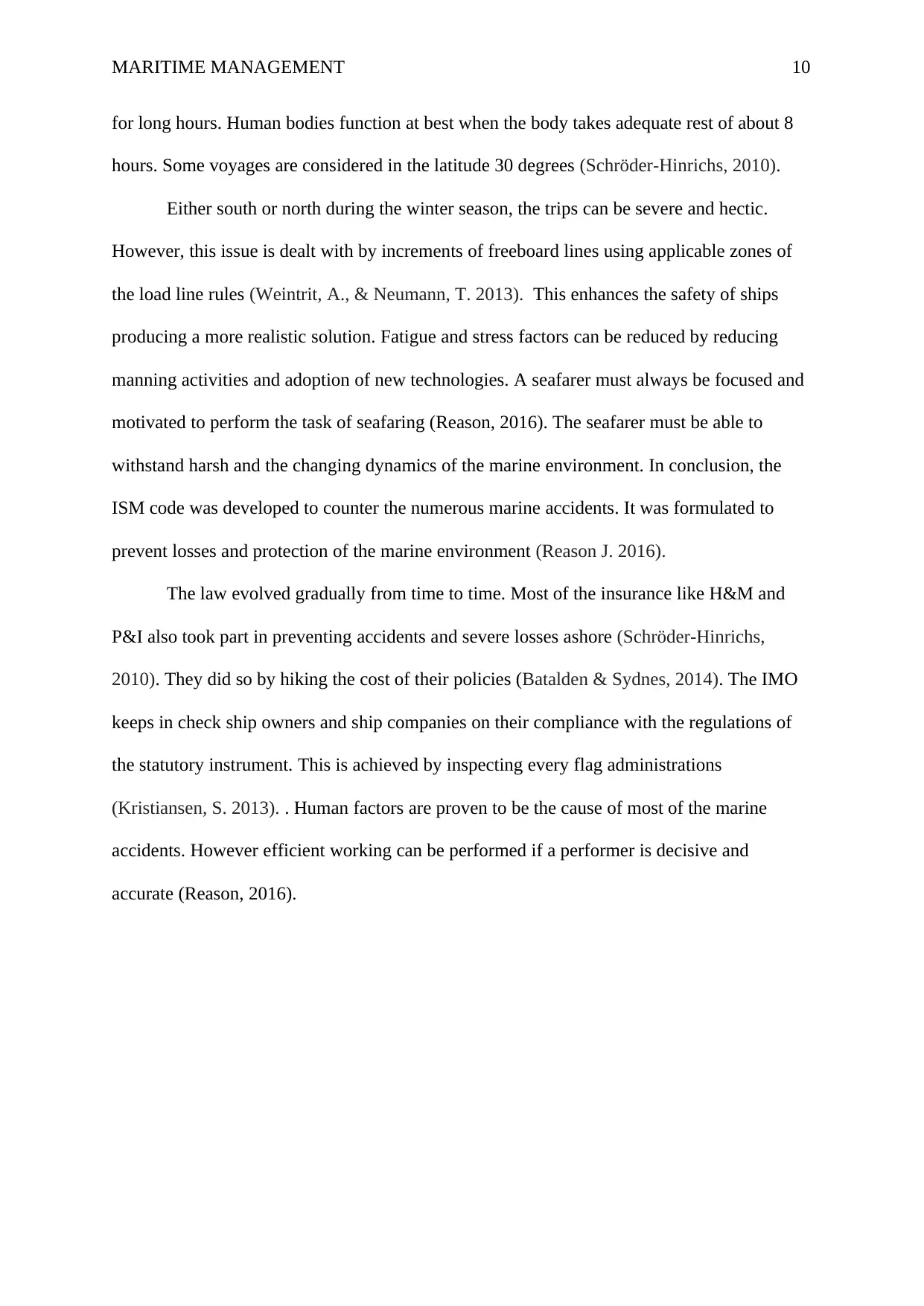
MARITIME MANAGEMENT 10
for long hours. Human bodies function at best when the body takes adequate rest of about 8
hours. Some voyages are considered in the latitude 30 degrees (Schröder-Hinrichs, 2010).
Either south or north during the winter season, the trips can be severe and hectic.
However, this issue is dealt with by increments of freeboard lines using applicable zones of
the load line rules (Weintrit, A., & Neumann, T. 2013). This enhances the safety of ships
producing a more realistic solution. Fatigue and stress factors can be reduced by reducing
manning activities and adoption of new technologies. A seafarer must always be focused and
motivated to perform the task of seafaring (Reason, 2016). The seafarer must be able to
withstand harsh and the changing dynamics of the marine environment. In conclusion, the
ISM code was developed to counter the numerous marine accidents. It was formulated to
prevent losses and protection of the marine environment (Reason J. 2016).
The law evolved gradually from time to time. Most of the insurance like H&M and
P&I also took part in preventing accidents and severe losses ashore (Schröder-Hinrichs,
2010). They did so by hiking the cost of their policies (Batalden & Sydnes, 2014). The IMO
keeps in check ship owners and ship companies on their compliance with the regulations of
the statutory instrument. This is achieved by inspecting every flag administrations
(Kristiansen, S. 2013). . Human factors are proven to be the cause of most of the marine
accidents. However efficient working can be performed if a performer is decisive and
accurate (Reason, 2016).
for long hours. Human bodies function at best when the body takes adequate rest of about 8
hours. Some voyages are considered in the latitude 30 degrees (Schröder-Hinrichs, 2010).
Either south or north during the winter season, the trips can be severe and hectic.
However, this issue is dealt with by increments of freeboard lines using applicable zones of
the load line rules (Weintrit, A., & Neumann, T. 2013). This enhances the safety of ships
producing a more realistic solution. Fatigue and stress factors can be reduced by reducing
manning activities and adoption of new technologies. A seafarer must always be focused and
motivated to perform the task of seafaring (Reason, 2016). The seafarer must be able to
withstand harsh and the changing dynamics of the marine environment. In conclusion, the
ISM code was developed to counter the numerous marine accidents. It was formulated to
prevent losses and protection of the marine environment (Reason J. 2016).
The law evolved gradually from time to time. Most of the insurance like H&M and
P&I also took part in preventing accidents and severe losses ashore (Schröder-Hinrichs,
2010). They did so by hiking the cost of their policies (Batalden & Sydnes, 2014). The IMO
keeps in check ship owners and ship companies on their compliance with the regulations of
the statutory instrument. This is achieved by inspecting every flag administrations
(Kristiansen, S. 2013). . Human factors are proven to be the cause of most of the marine
accidents. However efficient working can be performed if a performer is decisive and
accurate (Reason, 2016).
Secure Best Marks with AI Grader
Need help grading? Try our AI Grader for instant feedback on your assignments.
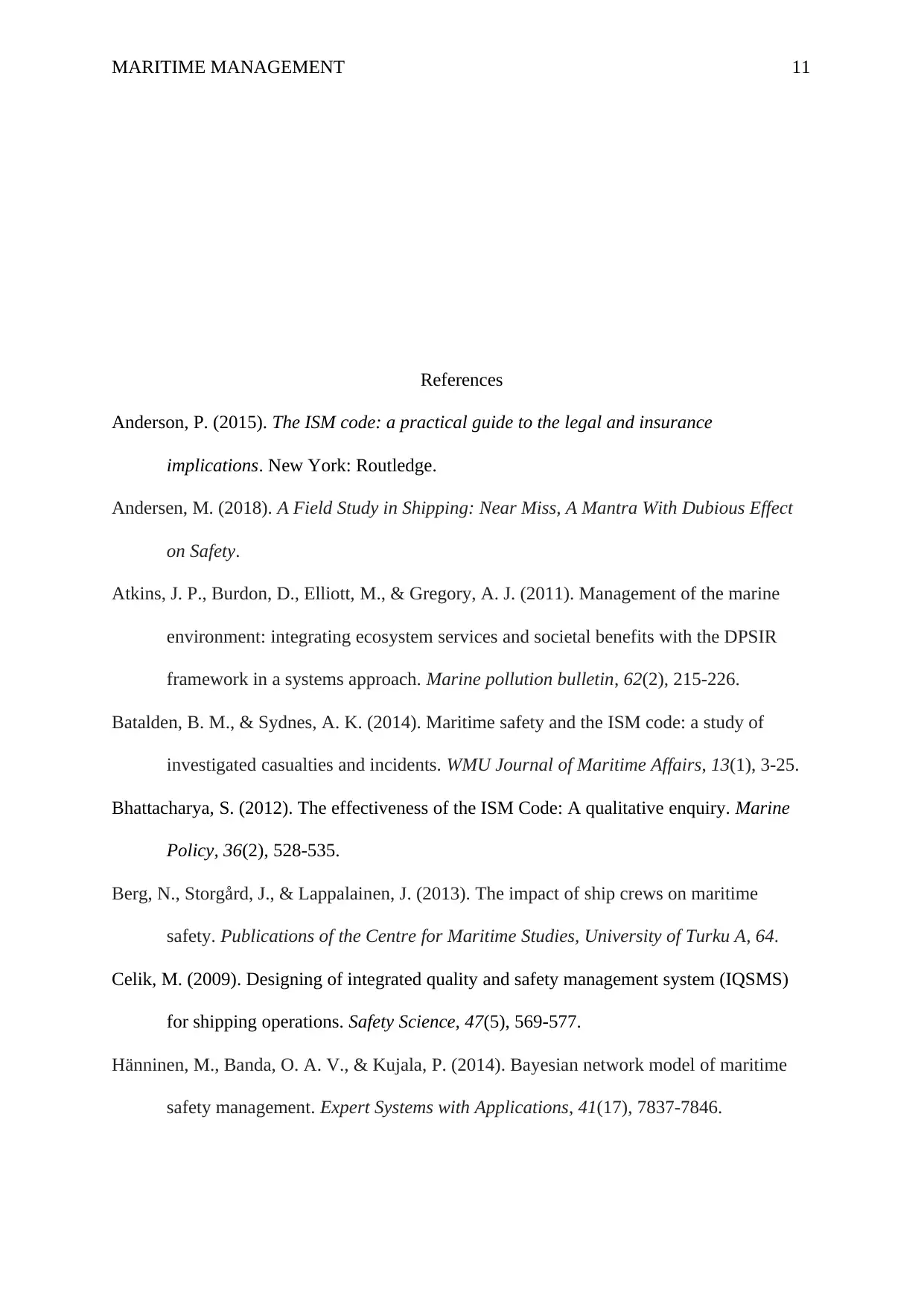
MARITIME MANAGEMENT 11
References
Anderson, P. (2015). The ISM code: a practical guide to the legal and insurance
implications. New York: Routledge.
Andersen, M. (2018). A Field Study in Shipping: Near Miss, A Mantra With Dubious Effect
on Safety.
Atkins, J. P., Burdon, D., Elliott, M., & Gregory, A. J. (2011). Management of the marine
environment: integrating ecosystem services and societal benefits with the DPSIR
framework in a systems approach. Marine pollution bulletin, 62(2), 215-226.
Batalden, B. M., & Sydnes, A. K. (2014). Maritime safety and the ISM code: a study of
investigated casualties and incidents. WMU Journal of Maritime Affairs, 13(1), 3-25.
Bhattacharya, S. (2012). The effectiveness of the ISM Code: A qualitative enquiry. Marine
Policy, 36(2), 528-535.
Berg, N., Storgård, J., & Lappalainen, J. (2013). The impact of ship crews on maritime
safety. Publications of the Centre for Maritime Studies, University of Turku A, 64.
Celik, M. (2009). Designing of integrated quality and safety management system (IQSMS)
for shipping operations. Safety Science, 47(5), 569-577.
Hänninen, M., Banda, O. A. V., & Kujala, P. (2014). Bayesian network model of maritime
safety management. Expert Systems with Applications, 41(17), 7837-7846.
References
Anderson, P. (2015). The ISM code: a practical guide to the legal and insurance
implications. New York: Routledge.
Andersen, M. (2018). A Field Study in Shipping: Near Miss, A Mantra With Dubious Effect
on Safety.
Atkins, J. P., Burdon, D., Elliott, M., & Gregory, A. J. (2011). Management of the marine
environment: integrating ecosystem services and societal benefits with the DPSIR
framework in a systems approach. Marine pollution bulletin, 62(2), 215-226.
Batalden, B. M., & Sydnes, A. K. (2014). Maritime safety and the ISM code: a study of
investigated casualties and incidents. WMU Journal of Maritime Affairs, 13(1), 3-25.
Bhattacharya, S. (2012). The effectiveness of the ISM Code: A qualitative enquiry. Marine
Policy, 36(2), 528-535.
Berg, N., Storgård, J., & Lappalainen, J. (2013). The impact of ship crews on maritime
safety. Publications of the Centre for Maritime Studies, University of Turku A, 64.
Celik, M. (2009). Designing of integrated quality and safety management system (IQSMS)
for shipping operations. Safety Science, 47(5), 569-577.
Hänninen, M., Banda, O. A. V., & Kujala, P. (2014). Bayesian network model of maritime
safety management. Expert Systems with Applications, 41(17), 7837-7846.
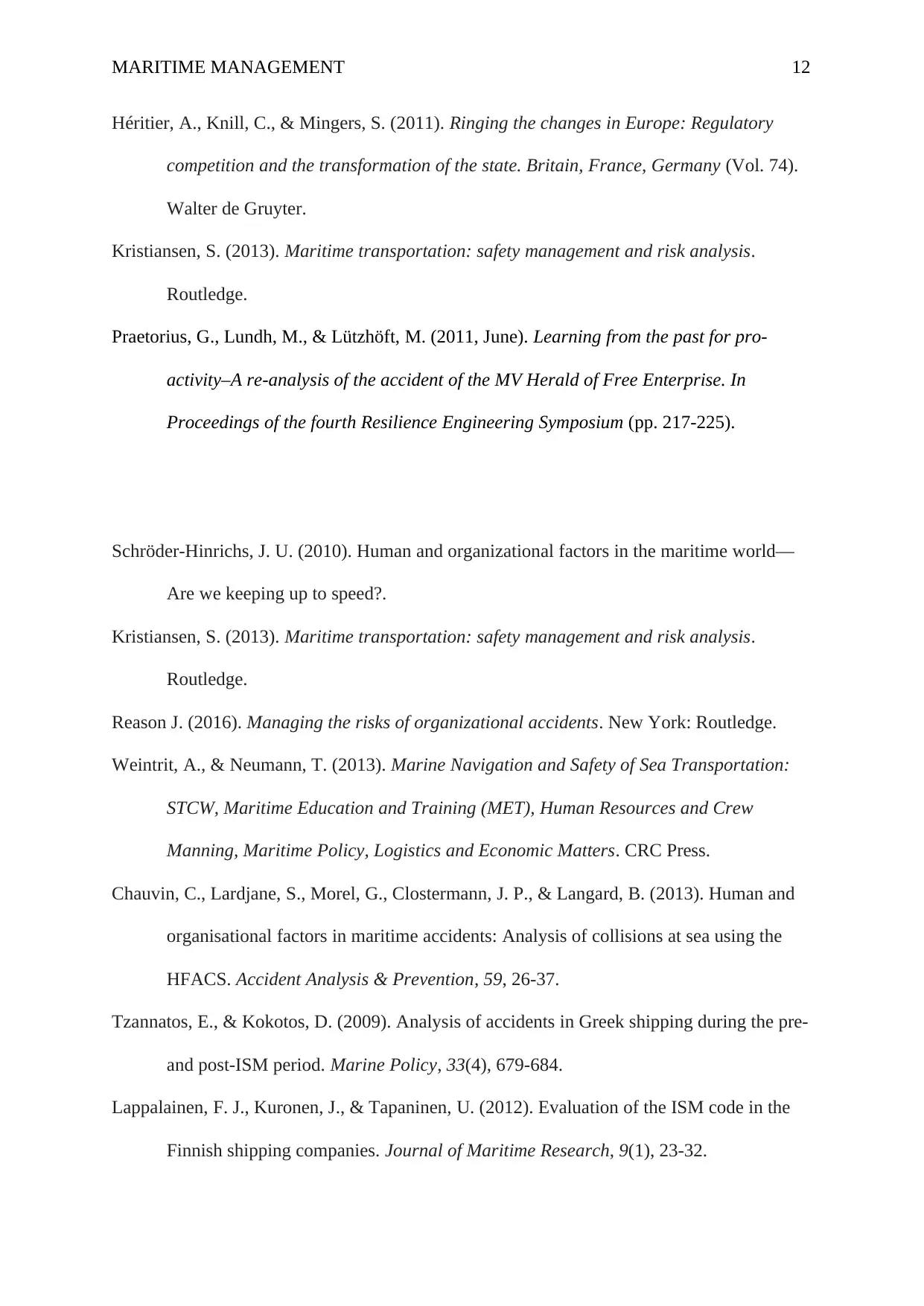
MARITIME MANAGEMENT 12
Héritier, A., Knill, C., & Mingers, S. (2011). Ringing the changes in Europe: Regulatory
competition and the transformation of the state. Britain, France, Germany (Vol. 74).
Walter de Gruyter.
Kristiansen, S. (2013). Maritime transportation: safety management and risk analysis.
Routledge.
Praetorius, G., Lundh, M., & Lützhöft, M. (2011, June). Learning from the past for pro-
activity–A re-analysis of the accident of the MV Herald of Free Enterprise. In
Proceedings of the fourth Resilience Engineering Symposium (pp. 217-225).
Schröder-Hinrichs, J. U. (2010). Human and organizational factors in the maritime world—
Are we keeping up to speed?.
Kristiansen, S. (2013). Maritime transportation: safety management and risk analysis.
Routledge.
Reason J. (2016). Managing the risks of organizational accidents. New York: Routledge.
Weintrit, A., & Neumann, T. (2013). Marine Navigation and Safety of Sea Transportation:
STCW, Maritime Education and Training (MET), Human Resources and Crew
Manning, Maritime Policy, Logistics and Economic Matters. CRC Press.
Chauvin, C., Lardjane, S., Morel, G., Clostermann, J. P., & Langard, B. (2013). Human and
organisational factors in maritime accidents: Analysis of collisions at sea using the
HFACS. Accident Analysis & Prevention, 59, 26-37.
Tzannatos, E., & Kokotos, D. (2009). Analysis of accidents in Greek shipping during the pre-
and post-ISM period. Marine Policy, 33(4), 679-684.
Lappalainen, F. J., Kuronen, J., & Tapaninen, U. (2012). Evaluation of the ISM code in the
Finnish shipping companies. Journal of Maritime Research, 9(1), 23-32.
Héritier, A., Knill, C., & Mingers, S. (2011). Ringing the changes in Europe: Regulatory
competition and the transformation of the state. Britain, France, Germany (Vol. 74).
Walter de Gruyter.
Kristiansen, S. (2013). Maritime transportation: safety management and risk analysis.
Routledge.
Praetorius, G., Lundh, M., & Lützhöft, M. (2011, June). Learning from the past for pro-
activity–A re-analysis of the accident of the MV Herald of Free Enterprise. In
Proceedings of the fourth Resilience Engineering Symposium (pp. 217-225).
Schröder-Hinrichs, J. U. (2010). Human and organizational factors in the maritime world—
Are we keeping up to speed?.
Kristiansen, S. (2013). Maritime transportation: safety management and risk analysis.
Routledge.
Reason J. (2016). Managing the risks of organizational accidents. New York: Routledge.
Weintrit, A., & Neumann, T. (2013). Marine Navigation and Safety of Sea Transportation:
STCW, Maritime Education and Training (MET), Human Resources and Crew
Manning, Maritime Policy, Logistics and Economic Matters. CRC Press.
Chauvin, C., Lardjane, S., Morel, G., Clostermann, J. P., & Langard, B. (2013). Human and
organisational factors in maritime accidents: Analysis of collisions at sea using the
HFACS. Accident Analysis & Prevention, 59, 26-37.
Tzannatos, E., & Kokotos, D. (2009). Analysis of accidents in Greek shipping during the pre-
and post-ISM period. Marine Policy, 33(4), 679-684.
Lappalainen, F. J., Kuronen, J., & Tapaninen, U. (2012). Evaluation of the ISM code in the
Finnish shipping companies. Journal of Maritime Research, 9(1), 23-32.
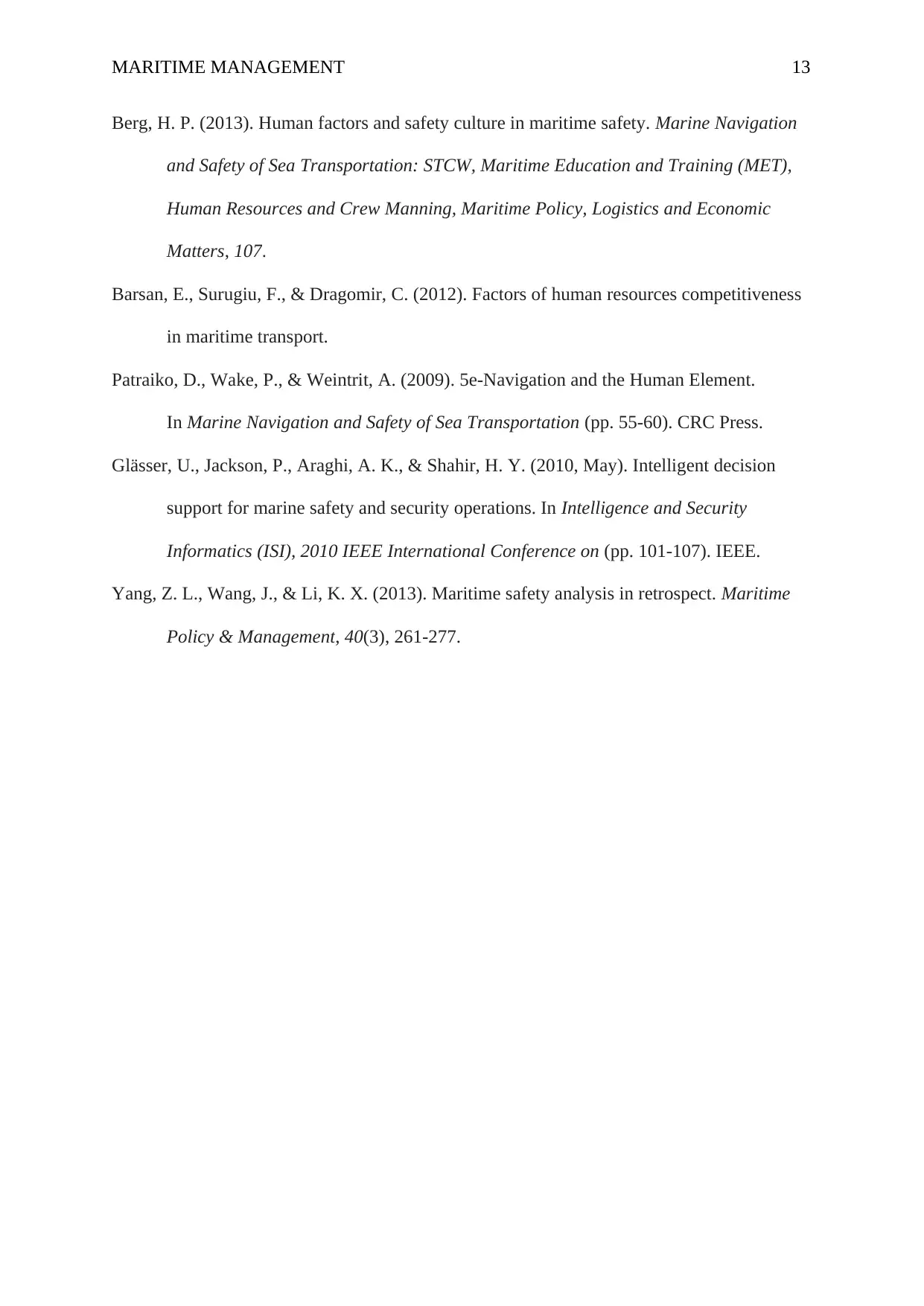
MARITIME MANAGEMENT 13
Berg, H. P. (2013). Human factors and safety culture in maritime safety. Marine Navigation
and Safety of Sea Transportation: STCW, Maritime Education and Training (MET),
Human Resources and Crew Manning, Maritime Policy, Logistics and Economic
Matters, 107.
Barsan, E., Surugiu, F., & Dragomir, C. (2012). Factors of human resources competitiveness
in maritime transport.
Patraiko, D., Wake, P., & Weintrit, A. (2009). 5e-Navigation and the Human Element.
In Marine Navigation and Safety of Sea Transportation (pp. 55-60). CRC Press.
Glässer, U., Jackson, P., Araghi, A. K., & Shahir, H. Y. (2010, May). Intelligent decision
support for marine safety and security operations. In Intelligence and Security
Informatics (ISI), 2010 IEEE International Conference on (pp. 101-107). IEEE.
Yang, Z. L., Wang, J., & Li, K. X. (2013). Maritime safety analysis in retrospect. Maritime
Policy & Management, 40(3), 261-277.
Berg, H. P. (2013). Human factors and safety culture in maritime safety. Marine Navigation
and Safety of Sea Transportation: STCW, Maritime Education and Training (MET),
Human Resources and Crew Manning, Maritime Policy, Logistics and Economic
Matters, 107.
Barsan, E., Surugiu, F., & Dragomir, C. (2012). Factors of human resources competitiveness
in maritime transport.
Patraiko, D., Wake, P., & Weintrit, A. (2009). 5e-Navigation and the Human Element.
In Marine Navigation and Safety of Sea Transportation (pp. 55-60). CRC Press.
Glässer, U., Jackson, P., Araghi, A. K., & Shahir, H. Y. (2010, May). Intelligent decision
support for marine safety and security operations. In Intelligence and Security
Informatics (ISI), 2010 IEEE International Conference on (pp. 101-107). IEEE.
Yang, Z. L., Wang, J., & Li, K. X. (2013). Maritime safety analysis in retrospect. Maritime
Policy & Management, 40(3), 261-277.
1 out of 13
Your All-in-One AI-Powered Toolkit for Academic Success.
+13062052269
info@desklib.com
Available 24*7 on WhatsApp / Email
![[object Object]](/_next/static/media/star-bottom.7253800d.svg)
Unlock your academic potential
© 2024 | Zucol Services PVT LTD | All rights reserved.